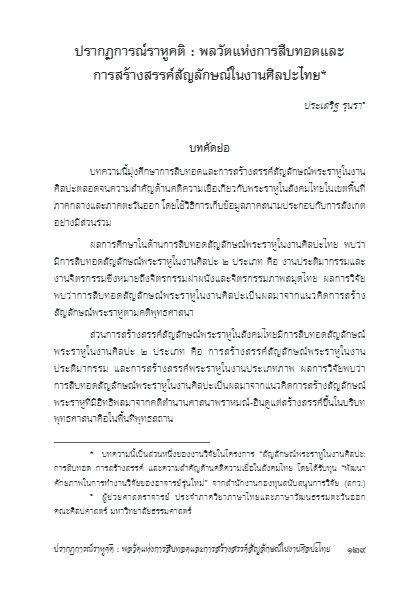ประเสริฐ รุนรา
บทคัดย่อ
บทความนี้มุ่งศึกษาการสืบทอดและการสร้างสรรค์สัญลักษณ์พระราหูในงานศิลปะตลอดจนความสำคัญด้านคติความเชื่อเกี่ยวกับพระราหูในสังคมไทยในเขตพื้นที่ภาคกลางและภาคตะวันออก โดยใช้วิธีการเก็บข้อมูลภาคสนามประกอบกับการสังเกตอย่างมีส่วนร่วม
ผลการศึกษาในด้านการสืบทอดสัญลักษณ์พระราหูในงานศิลปะไทย พบว่ามีการสืบทอดสัญลักษณ์พระราหูในงานศิลปะ 2 ประเภท คือ งานประติมากรรมและงานจิตรกรรมซึ่งหมายถึงจิตรกรรมฝาผนังและจิตรกรรมภาพสมุดไทย ผลการวิจัยพบว่าการสืบทอดสัญลักษณ์พระราหูในงานศิลปะเป็นผลมาจากแนวคิดการสร้างสัญลักษณ์พระราหูตามคติพุทธศาสนา
ส่วนการสร้างสรรค์สัญลักษณ์พระราหูในสังคมไทยมีการสืบทอดสัญลักษณ์พระราหูในงานศิลปะ 2 ประเภท คือ การสร้างสรรค์สัญลักษณ์พระราหูในงานประติมากรรม และการสร้างสรรค์พระราหูในงานประเภทภาพ ผลการวิจัยพบว่าการสืบทอดสัญลักษณ์พระราหูในงานศิลปะเป็นผลมาจากแนวคิดการสร้างสัญลักษณ์พระราหูที่มีอิทธิพลมาจากคติตำนานศาสนาพราหมณ์-ฮินดูแต่สร้างสรรค์ขึ้นในบริบทพุทธศาสนาคือในพื้นที่พุทธสถาน
ในด้านปัจจัยการสืบทอดสัญลักษณ์พระราหูในงานศิลปะพบ 3 ประการ ได้แก่ ประการแรก ความคิดเกี่ยวกับคติการสร้างพุทธสถานเป็นศูนย์กลางจักรวาล ประการที่สองความคิดเกี่ยวกับการบูชาพระพุทธเจ้าในอนาคต และประการสุดท้ายความคิดเกี่ยวกับกุศโลบายการสอนธรรมะในสังคมไทย ส่วนปัจจัยการสร้างสรรค์สัญลักษณ์พระราหูในงานศิลปะ พบปัจจัย 4 ประการ ได้แก่ ประการแรกอิทธิพลความเชื่อเกี่ยวกับโหราศาสตร์ในสังคมไทย ประการที่สอง ลักษณะและปรากฏการณ์ของพุทธศาสนาในสังคมไทย จำแนกเป็น 2 ปัจจัย คือ 1) พุทธศาสนาแบบประชานิยมในสังคมไทย และ 2) พุทธพาณิชย์ในสังคมไทย ประการที่สาม บทบาทหน้าที่ของพระราหูในฐานะสัญลักษณ์สากลในสังคมไทย และประการสุดท้ายการสร้างสรรค์ความหมายใหม่ของพระราหูในสังคมไทยปัจจุบัน จำแนกเป็น 3 ความหมาย คือ 1) พระราหู: สัญลักษณ์ของการสะเดาะเคราะห์ 2) พระราหู: สัญลักษณ์ของโชคลาภ และ 3) พระราหู: สัญลักษณ์ของการเปลี่ยนผ่าน
คำสำคัญ : พระราหู, สัญลักษณ์, คติความเชื่อ, การสืบทอด, การสร้างสรรค์
(ตีพิมพ์ใน วารสารไทยศึกษา ปีที่ 14 ฉบับที่ 1 (มกราคม – มิถุนายน 2561) หน้า 129-163)
Phenomenon of Belief in Rahu: Dynamics of Symbol Transmission and Creation in Thai Arts
Prasirt Runra
Abstract
This research focuses on the creation and succession of the Rahu symbol in Thai art, as well as the importance of the belief in Rahu in Thai society in the central, eastern and western regions by using field observation method, together with participant observation. The study of the succession of Rahu in Thai art found that there are two types of such representations: sculpture and Thai painting, including murals. The research found that the succession of the Rahu symbol in Thai art has been the result of the concept of Rahu according to Buddhism.
The research found that the concept of Rahu incorporates Brahman-Hindu ideas, but was created in a Buddhist context as it is used in Buddhist settings. The study found that the Rahu symbol is used in three ways. First is the idea of the creation of the Buddhist site as the center of the universe. Second is the idea of worshiping the Buddha in the future. The last factor is the idea of using Rahu to teach morals in Thai society. The symbolism of Rahu in art has four main factors. First, there is the idea of astrology in Thai society. Second are the characteristics and phenomena of Buddhism in Thai society, categorized into two factors: 1) popular Buddhism and 2) Buddhist commercialism. Third is the role of Rahu as a universal symbol in Thai society. Lastly, a new meaning of Rahu in Thai society can be classified into three meanings: 1) Rahu: the symbol for elimination of evil; 2) Rahu: the symbol of fortune; and 3) Rahu: the symbol of change.
Keywords : Rahu, Symbol, Belief, Transmission, Creation
(Published in Journal of Thai Studies Volume 14 Number 1 (January – June 2018) Page 105-127)
บทความ / Full Text : Download
